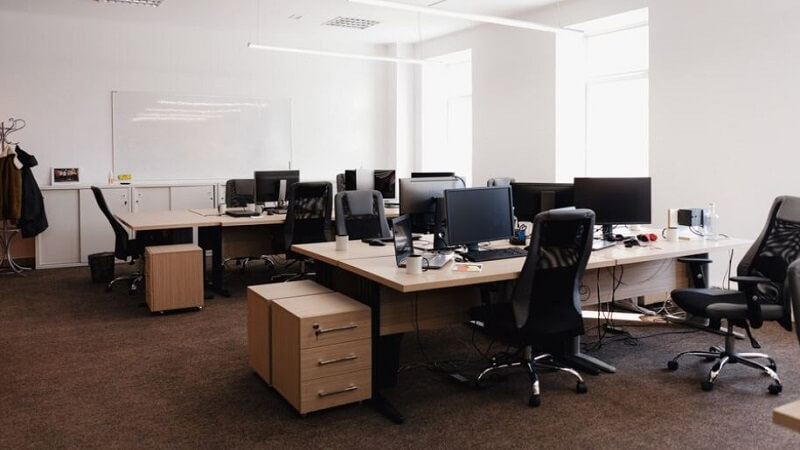Hyderabad’s IT culture is booming and many startups and tech giants are setting the pace for innovative workplaces. From open layouts to collaborative spaces, leading companies like Google Hyderabad and Microsoft India are designing for today’s employees, making workspaces more inviting and efficient.
Amid this shift, the concept of a zero-waste office is no longer just a buzzword – it’s a growing trend in cities like Hyderabad. While designing a zero-waste office helps reduce carbon footprint and creates healthier work environments, building a sustainable office is not just about saving the planet – it’s about meeting the needs of the modern workforce.
But what does a zero-waste office look like, and how can modern workspaces integrate this concept? If you are one of the companies rethinking your office space, partnering with an office interior designer in Hyderabad can help your company create a functional and eco-friendly workplace.
Let’s discover 8 simple ways to design an office that capitalises on zero-waste practices and makes the most of every resource.
1. Choose Sustainable and Recyclable Furniture and Decor for a Green Office Interior Design
Start by choosing furniture made from recycled or sustainable materials. Look for desks, chairs and shelves made from reclaimed wood, recycled metal or organic fabrics. These reduce waste and are durable.
For decor, use items that are biodegradable or can be repurposed. Adding plants brightens up the office without contributing to waste. Whenever possible, avoid plastics and choose decor that fits into a long-term zero-waste plan.
2. Go Fully Paperless by Embracing Digital Solutions for Communication and File Sharing
Going paperless is one of the best ways to reduce office waste. Switch to cloud-based tools like Google Drive or Dropbox for storing files and sharing documents. This eliminates physical paperwork and makes file management easier.
Use digital communication platforms like Slack or Microsoft Teams to reduce paper memos and printed notices. Tools like Evernote combine text and voice note features and can replace paper notebooks for meetings. Encourage your team to go digital and cut down on clutter and waste in the office.
3. Set Up Easy Composting Stations Around the Office Interior Designs to Manage Waste Responsibly
It’s impossible to eliminate all waste, but an effective recycling program can manage most of it. Set up recycling bins throughout the office for paper, plastic and glass. Label these bins clearly so everyone knows where to put things.
If your office has a kitchen or snack area, consider adding a compost bin for organic waste, like coffee grounds or food scraps. This reduces the trash that ends up in landfills. Partner with local recycling and composting services to ensure your waste is handled properly.
4. Upgrade to Energy-Efficient Lights and Appliances for Lower Power Use
Reducing your office’s energy consumption can help you achieve your waste reduction goals. Start by switching to LED lights, which use less electricity than traditional bulbs. Consider motion sensors in meeting rooms to turn off lights when not in use.
Energy-efficient appliances, like low-power computers and printers, can also help reduce energy consumption. Simple changes like adjusting the office thermostat or opening windows for ventilation can lower your energy footprint.
5. Opt for Durable and Reusable Office Supplies to Minimise the Need for Single-Use Items
Single-use items generate a lot of waste in most offices. Switch to reusable supplies like refillable pens, notebooks and metal staplers. Encourage your team to bring their own reusable water bottles and coffee cups.
Instead of using disposable products like paper towels and plastic cutlery in the kitchen, stock up on reusable dishware and washable towels. These little changes can add up to a big reduction in the waste your office produces daily.
6. Switch to Eco-Friendly Cleaning Products for a Greener Office Interior Design
Office cleaning can generate waste if you use harsh chemicals or disposable wipes. Switch to eco-friendly cleaning products that are non-toxic and biodegradable. They’re better for the planet and safer for your employees.
Choose reusable cleaning cloths over paper towels and look for products in refillable containers to reduce packaging waste. This is an easy win for your office’s environmental footprint.
7. Design Workspaces to Maximise Natural Resources Like Light and Airflow
A well-designed office supports your zero-waste goals. Place workstations near windows to make the most of natural light and reduce the need for artificial lighting. Open layouts and window placement improve airflow and reduce aircon use.
Plants throughout the office improve air quality and create a calming environment. By maximising sunlight and fresh air, you can create a more comfortable workspace and reduce energy consumption.
8. Create a Waste-Free Culture That Encourages Everyone to Get Involved
A zero-waste office isn’t just about policies, it’s about getting everyone on board. Start by educating employees on the zero waste way. Simple things, like providing reusable lunch containers or offering prizes for waste reduction efforts can generate excitement.
Running waste reduction workshops or encouraging the team to share their tips can keep everyone engaged. Making sustainability part of your office culture will help create a sense of teamwork.
Lead the Charge in Sustainable Office Design with a Zero-Waste Strategy
A zero-waste office implies making conscious choices that reduce waste and increase efficiency. Whether it’s using eco-friendly materials, going paperless, or involving the team in sustainable practices, every little step helps. Work with an office interior designer in Hyderabad to bring these ideas to life and create a space that’s not only eco-friendly but inspiring for everyone.
